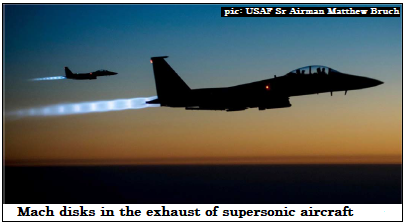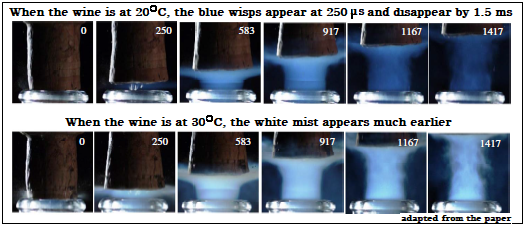The plumes that appear when uncorking champagne can take different colours, says S.Ananthanarayanan.
The ‘pop’, when uncorking a bottle of sparkling wine is iconic. Opening the bottle gently, with a ‘subdued sigh’, would be safer, but celebration and ceremony call for the explosion, shower of champagne and the cork shooting out
Gérard Liger-Belair and Daniel Cordier, from the Université de Reims Champagen-Ardenne, in the heart of the Champagne wine growing region, and Robert Georges from the Institute of Physics, Université de Rennes dissect, into microseconds, the process of the sharp report when the bottle opens. In a paper in Science Advances, the journal of the American Association for the Advancement of Science, they find that complex mechanisms are at play and the colour of vapours that arise when a bottle of sparkling wine is opened depends on the temperature of the wine.
Sparkling wines are so called because of the stream of tiny bubbles that rise to the surface, and burst into a misty spray, as soon as a bottle is opened. The bubbles, of course, are carbon dioxide gas, dissolved in the wine under pressures, which issue forth when the cork is pulled. It is the same with soda water, where carbon dioxide gas is dissolved in water. The process of putting the gas into wine, by a natural process, however, dates earlier than the process for soda water. The first process was by Dom Pérignon, a 17th Century monk in the Champagne region in France. Soda water was invented a century later, when Joseph Priestly discovered carbon dioxide.
Carbon dioxide is given off in wine making, when glucose in sugars, in the presence of yeast, breaks down into alcohol. The process is described like this:
, where C2H5OH is potable alcohol. This reaction, in fact, amounts to partial burning of glucose into water and carbon dioxide, partial because the alcohol can again burn to 2CO2 and H2O. In wine making, the CO2 produced is allowed to escape, through an air lock, until all the sugar has fermented, and what is left is the wine. When, by accident, the wine was bottled a little early, some CO2 was still produced, which bubbled out when the bottle was opened, the beginning of sparkling wine.
Dom Pérignon is credited with refining the process. The first steps were to control the quantity of sugar for the second fermentation and then to strengthen the bottle, to withstand the pressure. But the important step was to keep the wine clear. During fermentation, spent yeast cells settle at the bottom as the ‘lees’ and wine has to be decanted, to be free of lees. In the case of sparkling wine, the bottle is already corked and there is no occasion to decant the wine. And then, as the dissolved gas escapes vigorously when the bottle is opened, the lees that have settled to the bottom would be disturbed and cloud the wine
The Dom Pérignon method is use two sets of corks. The first cork is inserted when the secondary fermentation is happening, and the bottle is stored bottom-up. The lees hence settle in the neck of the bottle, on the cork. When this process is over, the neck of the bottle is frozen, so that the frozen wine acts as a sealant. The cork, and the lees, are then extracted, and a fresh cork inserted – so that the wine is both carbonated and free from yeast residue.
Production of champagne has now become a huge industry and quality sparkling wines are produced in many more places in France and the world. And always, an important ritual at the start of many events, the launching of a ship, a product, a christening, or any kind of celebration is to open a bottle of champagne, and with a sound as loud as possible, of the cork being extracted.
The sound, in fact, is a case of the ‘sonic boom’ when things cross the speed of sound. The pressure of the carbon dioxide gas dissolved in the wine is in region of 7.5 times the atmospheric pressure. When the pressure is suddenly released, the gas, air and vapour in the bottleneck rush out, and so does carbon dioxide that leaves the dissolved state. The pressure difference is sufficient for the jet being expelled to exceed the speed of sound, and there are shock waves, the so-called Mach disks (after an Austrian physicist who first described them), which the sharp crack, the ‘BANG’, when the bottle is opened.

Apart from the sound, the characteristic of a champagne opening is the fine mist, the cloud that appears around the mouth of the bottle. The usual understanding, the Reims paper says, is that the gas and vapour rushing out of the bottle expands rapidly, before it can absorb heat from the surroundings, and hence, it cools. And the surrounding air cools below the dew point, to form droplets of water, even tiny bits of ice. The grey-white colour, the paper says, is a result of scattering of light, an effect called Mei scattering, where light is scattered by particles that are larger than the wavelength of light, an effect that is responsible for the white colour of clouds.
The paper refers to recent studies where the gas emerging from champagne bottles at different temperatures has been filmed with high-speed cameras. Contrary to what we would expect, the paper says, the warmer the wine in the bottle, the colder the gas gets when it expands on emerging. When champagne, usually drunk chilled, was warmed to 20°C, the temperature of the emerging gas went down to -90°C, which is below the freezing temperature of CO2. And in place of the grey-white fog that we are used to, we found, to our surprise, a plume of short-lived wisps of blue!
The appearance of blue scattered light is Raleigh scattering, scattering by particles that are smaller than the wavelength of light, just what accounts for the blue of the sky. The studies that found the blue wisps had noted that the blue haze was an indicator of freezing of the CO2, which inhibited the condensation of water vapour, and kept the scattering centres small.
times that outside, and 30°C when the pressure is 10.2 times higher. Here, it was found that as the temperature rose from 20°C, the wispy blue disappeared and turned grey-white, characteristic of Mei scattering, by larger particles. The authors explain the difference as caused by the way CO2 and water vapour behave, leading to larger dry ice particles. The paper carries a panel of pictures that display the growth of the blue mist, in the 20°C wine, from the 250th microsecond after the cork is pulled, and as it grows for some milliseconds. In the case of wine at 30°C, the white, CO2 freezing plume appears much earlier, as a while cloud.

------------------------------------------------------------------------------------------ Do respond to : response@simplescience.in-------------------------------------------